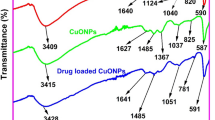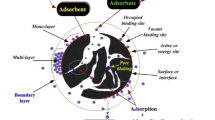Abstract
In this study, the effects of pre-oxidants permanganate (PM), persulfate (PS), hydrogen peroxide (PO), and ozone (OZ)) and/or adsorption on pseudoboemite-chitosan shell magnetic nanoparticles (ACMNs) on haloacetonitrile (HAN) and trichloronitromethane (TCNM) formation from aspartic acid (Asp; positive charge) and/or histidine (His; negative charge) were compared. Asp and His apparently do not interact in aqueous solution during chlorination. Asp and/or His can undergo partially oxidation by PM, but are recalcitrant to direct oxidation by PS and PO. Pre-oxidation with OZ decreases the formation of HANs but increases the formation of TCNM. ACMN prefers to adsorb Asp over His in the competitive sorption of coexisting Asp and His because of attractive electrostatic interactions. The rank order for the effect of the pre-oxidants and ACMN adsorption on dichloroacetonitrile and trichloroacetonitrile formation is OZ and ACMN adsorption > PM and ACMN adsorption > PS and ACMN adsorption > PO and ACMN adsorption; that for the effect of the pre-oxidants and ACMN adsorption on TCNM formation is PM and ACMN adsorption > PS and ACMN adsorption > PO and ACMN adsorption > OZ and ACMN adsorption. The favored adsorption of Asp over His by ACMN is weakened by pre-oxidation.





Similar content being viewed by others
References
Abdel Daiem MM, Rivera-Utrilla J, Sánchez-Polo M, Ocampo-Pérez R (2015) Single, competitive, and dynamic adsorption on activated carbon of compounds used as plasticizers and herbicides. Sci Total Environ 537:335–342
Bhatnagar A, Sillanpää M (2017) Removal of natural organic matter (NOM) and its constituents from water by adsorption—a review. Chemosphere 166:497–510
Bond T, Henriet O, Goslan EH, Parsons SA, Jefferson B (2009) Disinfection byproduct formation and fractionation behavior of natural organic matter surrogates. Environ Sci Technol 43:5982–5989
Bond T, Huang J, Templeton MR, Graham N (2011) Occurrence and control of nitrogenous disinfection by-products in drinking water—a review. Water Res 45:4341–4354
Bond T, Templeton MR, Rifai O, Ali H, Graham NJD (2014a) Chlorinated and nitrogenous disinfection by-product formation from ozonation and post-chlorination of natural organic matter surrogates. Chemosphere 111:218–224
Bond T, Kamal NHM, Bonnisseau T, Templeton MR (2014b) Disinfection by-product formation from the chlorination and chloramination of amines. J Hazard Mater 278:288–296
Chen B, Westerhoff P (2010) Predicting disinfection by-product formation potential in water. Water Res 44(13):3755–3762
Chen W, Liu Z, Tao H, Xu H, Gu Y, Chen Z, Yu J (2017) Factors affecting the formation of nitrogenous disinfection by-products during chlorination of aspartic acid in drinking water. Sci Total Environ 575:519–524
Cheng W, Dastgheib SA, Karanfil T (2005) Adsorption of dissolved natural organic matter by modified activated carbons. Water Res 39(11):2281–2290
Chu W, Gao N, Deng Y, Templeton MR, Yin D (2011a) Impacts of drinking water pretreatments on the formation of nitrogenous disinfection by-products. Bioresource Technol 102:11161–11166
Chu WH, Gao NY, Deng Y, Templeton MR, Yin DQ (2011b) Formation of nitrogenous disinfection by-products from pre-chloramination. Chemosphere 85:1187–1191
Chu W, Gao N, Krasner SW, Templeton MR, Yin D (2012) Formation of halogenated C-, N-DBPs from chlor(am)ination and UV irradiation of tyrosine in drinking water. Environ Pollut 161:8–14
Chu W, Gao N, Yin D, Krasner SW, Mitch WA (2014) Impact of UV/H2O2 pre-oxidation on the formation of haloacetamides and other nitrogenous disinfection byproducts during chlorination. Environ Sci Technol 48:12190–12198
Chu W, Li D, Gao N, Templeton MR, Tan C, Gao Y (2015a) The control of emerging haloacetamide DBP precursors with UV/persulfate treatment. Water Res 72:340–348
Chu W, Li D, Gao N, Yin D, Zhang Y, Zhu Y (2015b) Comparison of free amino acids and short oligopeptides for the formation of trihalomethanes and haloacetonitriles during chlorination: effect of peptide bond and pre-oxidation. Chem Eng J 281:623–631
Croue JP, Reckhow DA (1989) Destruction of chlorination byproducts with sulfite. Environ Sci Technol 23:1412–1419
Dastgheib SA, Karanfil T, Cheng W (2004) Tailoring activated carbons for enhanced removal of natural organic matter from natural waters. Carbon 42:547–557
Dong C, Chen W, Liu C (2014) Preparation of novel magnetic chitosan nanoparticle and its application for removal of humic acid from aqueous solution. Appl Surf Sci 292:1067–1076
Fang J, Yang X, Ma J, Shang C, Zhao Q (2010) Characterization of algal organic matter and formation of DBPs from chlor(am)ination. Water Res 44:5897–5906
Frank H, Patrick S, Peter W, Hannes F (2000) Export of dissolved organic carbon and nitrogen from gleysol dominated catchments—the significance of water flow paths. Biogeochemistry 50:137–161
Hong HC, Wong MH, Liang Y (2009) Amino acids as precursors of trihalomethane and haloacetic acid formation during chlorination. Arch Environ Contam Toxicol 56:638–645
Hristovski K, Westerhoff P, Moller T, Sylvester P (2009) Effect of synthesis conditions on nano-iron (hydr)oxide impregnated granulated activated carbon. Chem Eng J 146:237–243
Iriartevelasco U, Álvarezuriarte JI, Chimenoalanís N, Gonzálezvelasco JR (2008) Natural organic matter adsorption onto granular activated carbons: implications in the molecular weight and disinfection byproducts formation. Ind Eng Chem Res 47:7868–7876
Jia A, Wu C, Duan Y (2016) Precursors and factors affecting formation of haloacetonitriles and chloropicrin during chlor(am)ination of nitrogenous organic compounds in drinking water. J Hazard Mater 308:411–418
Jiang H, Chen P, Luo S, Luo X, Tu X, Cao Q, Zhou Y, Zhang W (2012) Synthesis of novel biocompatible composite Fe3O4/ZrO2/chitosan and its application for dye removal. J Inorg Organomet Polym Mater 23:393–400
Jones DB, Song H, Karanfil T (2012) The effects of selected preoxidation strategies on I-THM formation and speciation. Water Res 46:5491–5498
Krasner SW, Westerhoff P, Chen B, Rittmann BE, Amy G (2009) Occurrence of disinfection byproducts in United States wastewater treatment plant effluents. Environ Sci Technol 43:8320–8325
Krasner SW, Mitch WA, Westerhoff P, Dotson A (2012) Formation and control of emerging C- and N-DBPs in drinking water. J Am Water Works Ass 104:582–595
Krasner SW, Mitch WA, McCurry DL, Hanigan D, Westerhoff P (2013) Formation, precursors, control, and occurrence of nitrosamines in drinking water: a review. Water Res 47:4433–4450
Mao Y, Wang X, Yang H, Wang H, Xie YF (2014) Effects of ozonation on disinfection byproduct formation and speciation during subsequent chlorination. Chemosphere 117:515–520
Meon B, Kirchman DL (2001) Dynamics and molecular composition of dissolved organic material during experimental phytoplankton blooms. Mar Chem 75:185–199
Morales MA, Rodrigues ECDS, Amorim ASCM, Soares JM, Galembeck F (2013) Size selected synthesis of magnetite nanoparticles in chitosan matrix. Appl Surf Sci 275:71–74
Muellner MG, Wagner ED, McCalla K, Richardson SD, Woo Y, Plewa MJ (2007) Haloacetonitriles vs. regulated haloacetic acids: are nitrogen-containing DBPs more toxic? Environ Sci Technol 41:645–651
Munch JW, Bassett MV (2006) Method development for the analysis of N-nitrosodimethylamine and other N-nitrosamines in drinking water at low nanogram/liter concentrations using solid-phase extraction and gas chromatography with chemical ionization tandem mass spectrometry. J AOAC Int 89:486–497
Oliver BG (1983) Dihaloacetonitriles in drinking water: algae and fulvic acid as precursors. Environ Sci Technol 17:80–83
Regti A, Ayouchia HBE, Laamari MR, Stiriba SE, Anane H, Haddad ME (2016) Experimental and theoretical study using DFT method for the competitive adsorption of two cationic dyes from wastewaters. Appl Surf Sci 390:311–319
Richardson S, Plewa M, Wagner E, Schoeny R, Demarini D (2007) Occurrence, genotoxicity, and carcinogenicity of regulated and emerging disinfection by-products in drinking water: a review and roadmap for research. Mutat Res Rev Mutat Res 636:178–242
Rook JJ (1973) Formation of haloforms during chlorination of natural water. Water Treat Exam 23(2):234–243
Shah AD, Mitch WA (2012) Halonitroalkanes, halonitriles, haloamides, and N-nitrosamines: a critical review of nitrogenous disinfection byproduct formation pathways. Environ Sci Technol 46:119–131
Shan J, Hu J, Sule Kaplan-Bekaroglu S, Song H, Karanfil T (2012) The effects of pH, bromide and nitrite on halonitromethane and trihalomethane formation from amino acids and amino sugars. Chemosphere 86:323–328
Uddin MK (2017) A review on the adsorption of heavy metals by clay minerals, with special focus on the past decade. Chem Eng J 308:438–462
Ueno H, Moto T, Sayato Y, Nakamuro K (1996) Disinfection by-products in the chlorination of organic nitrogen compounds—by-products from kynurenine. Chemosphere 8:1425–1433
Wan Z, Chen W, Liu C, Liu Y, Dong C (2015) Preparation and characterization of γ-AlOOH@CS magnetic nanoparticle as a novel adsorbent for removing fluoride from drinking water. J Colloid Interf Sci 443:115–124
Xie P, Ma J, Fang J, Guan Y, Yue S, Li X, Chen L (2013) Comparison of permanganate preoxidation and preozonation on algae containing water: cell integrity, characteristics, and chlorinated disinfection byproduct formation. Environ Sci Technol 47:14051–14061
Xie P, Ma J, Liu W, Zou J, Yue S (2015) Impact of UV/persulfate pretreatment on the formation of disinfection byproducts during subsequent chlorination of natural organic matter. Chem Eng J 269:203–211
Yang X, Guo W, Shen Q (2011) Formation of disinfection byproducts from chlor(am)ination of algal organic matter. J Hazard Mater 197:378–388
Yang X, Shen Q, Guo W, Peng J, Liang Y (2012) Precursors and nitrogen origins of trichloronitromethane and dichloroacetonitrile during chlorination-chloramination. Chemosphere 88:25–32
Zhang J, Liu F (2012) Adsorption of natural organic matter onto a composite adsorbent prepared with chitosan and powdered activated carbon. Desalin Water Treat 20:291–296
Zhao Y, Xiao F, Wang D, Yan M, Bi Z (2013) Disinfection byproduct precursor removal by enhanced coagulation and their distribution in chemical fractions. J Environ Sci 11:2207–2213
Zhou R, Zhu L, Yang K, Chen Y (2006) Distribution of organochlorine pesticides in surface water and sediments from Qiantang River, East China. J Hazard Mater 137:68–75
Acknowledgements
This investigation was supported by the National Science Foundation of China (NSFC) Award No. 51438006 and Priority Academic Program Development of Jiangsu Higher Education Institutions.
Author information
Authors and Affiliations
Corresponding authors
Additional information
Responsible editor: Vítor Pais Vilar
Highlights
• HAN and TCNM formation increases initially and then decreased during chlorination.
• ACMN prefers to adsorb Asp over His because of attractive electrostatic interaction.
• The favored adsorption of Asp over His by ACMN is weakened after pre-oxidation.
• PM and ACMN is a better choice in controlling AA-derived HANs and TCNM.
Electronic supplementary material
ESM 1
(DOCX 59 kb).
Rights and permissions
About this article
Cite this article
Liu, Z., Chen, W., Yu, H. et al. Effects of pre-oxidation and adsorption on haloacetonitrile and trichloronitromethane formation during subsequent chlorination. Environ Sci Pollut Res 24, 21836–21845 (2017). https://doi.org/10.1007/s11356-017-9843-2
Received:
Accepted:
Published:
Issue Date:
DOI: https://doi.org/10.1007/s11356-017-9843-2




